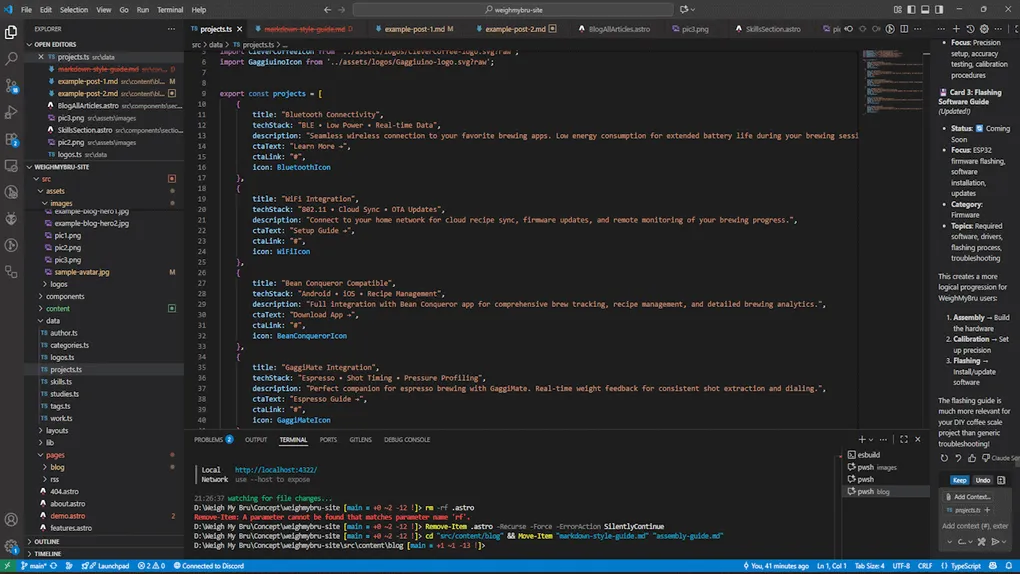
Flashing Software Guide
Flashing
WeighMyBru ESP32 Flash Guide - PlatformIO
Prerequisites Check
- ✅ VSCode installed
- ✅ PlatformIO extension installed
- ✅ ESP32-S3-WROOM Dev Board
- ✅ USB cable for connection
Step 1: Install Git (if not already installed)
Windows:
- Download Git from git-scm.com
- Run the installer with default settings
- Open Command Prompt or PowerShell and verify:
git --version
macOS:
# Using Homebrew
brew install git
# Or download from git-scm.comLinux (Ubuntu/Debian):
sudo apt update
sudo apt install gitStep 2: Clone the WeighMyBru Repository
-
Open Terminal/Command Prompt
-
Navigate to your projects directory:
cd ~/Documents # or wherever you keep projects mkdir esp32-projects # optional: create a projects folder cd esp32-projects -
Clone the repository:
git clone https://github.com/031devstudios/weighmybru2.git cd weighmybru2
Step 3: Open Project in VSCode with PlatformIO
-
Launch VSCode
-
Open the project folder:
- File → Open Folder
- Navigate to and select the
weighmybru2folder you just cloned - Click “Select Folder”
-
Wait for PlatformIO to initialize (you’ll see activity in the bottom status bar)
Step 4: Verify/Configure platformio.ini
Check if the project has a platformio.ini file in the root directory. If not, or if you need to modify it for ESP32-S3, create/update it with:
[env:esp32-s3-devkitc-1]
platform = [email protected]
board = esp32-s3-devkitc-1
framework = arduino
monitor_speed = 115200
board_upload.flash_size = 4MB
board_build.filesystem = littlefs
board_build.partitions = huge_app.csv
upload_protocol = esptool
upload_speed = 460800
upload_flags =
--chip=esp32s3
--before=default_reset
--after=hard_reset
monitor_rts = 0
monitor_dtr = 0
build_flags =
-DARDUINO_USB_CDC_ON_BOOT=1
-DBOARD_HAS_PSRAM
-Os
-DCORE_DEBUG_LEVEL=0
lib_deps =
robtillaart/HX711@^0.6.0
https://github.com/me-no-dev/ESPAsyncWebServer.git
https://github.com/me-no-dev/AsyncTCP.git
h2zero/NimBLE-Arduino@^1.4.0
adafruit/Adafruit SSD1306@^2.5.7
adafruit/Adafruit GFX Library@^1.11.9Step 5: Hardware Connection
- Connect your ESP32 to your computer via USB cable
- Put ESP32 in flash mode (if required):
- Hold BOOT button
- Press and release RESET button
- Release BOOT button
- (Some boards auto-reset, so this may not be necessary)
Step 6: Identify COM Port
In VSCode with PlatformIO:
- Look at the bottom blue status bar
- You should see a COM port listed (e.g., “COM3” on Windows, “/dev/ttyUSB0” on Linux)
- If not visible, click the PlatformIO icon in the left sidebar → Devices
Alternatively check manually:
- Windows: Device Manager → Ports (COM & LPT)
- macOS/Linux:
ls /dev/tty*ordmesg | grep tty
Step 7: Build and Upload
Using PlatformIO GUI:
- Click the PlatformIO icon in the left sidebar (alien head icon)
- Under “PROJECT TASKS” expand your environment (e.g., esp32-s3-devkitc-1)
- Click “Build” to compile the code first
- Wait for successful build (check terminal output)
- Click “Upload” to flash the ESP32
Using PlatformIO Terminal:
- Open PlatformIO terminal: Terminal → New Terminal
- Build the project:
pio run - Upload to ESP32:
pio run -t upload && -t uploadfs
Using VSCode Status Bar:
- Click the checkmark (✓) in the blue bottom bar to build
- Click the arrow (→) in the blue bottom bar to upload
Step 8: Monitor Serial Output
- Click the monitor plug icon in the blue status bar, or
- In PlatformIO sidebar: expand your environment → click “Monitor”
- Or use terminal command:
pio device monitor
Troubleshooting
Upload Issues:
- Wrong COM port: Check device manager/system and update platformio.ini if needed
- Board not in flash mode: Try the BOOT+RESET procedure again
- Driver issues: Install ESP32 USB drivers from Espressif’s website
- Permission denied (Linux/macOS): Add user to dialout group:
sudo usermod -a -G dialout $USER
Build Issues:
- Missing libraries: Check if libraries need to be installed (they’ll be listed in build errors)
- Wrong board config: Verify your ESP32-S3 variant matches the platformio.ini settings
Cannot find device:
# Check if device is detected
pio device list
# On Linux, you might need:
sudo chmod 666 /dev/ttyUSB0 # or your specific deviceWeighMyBru Specific Notes
Based on the project description, this scale project includes:
- Webserver functionality - After flashing, the ESP32 will host a web interface
- WiFi connectivity - You’ll need to configure WiFi credentials
- Bluetooth support - For GaggiMate integration
- HX711 load cell interface - Make sure your hardware connections match the code
Post-Flash Configuration:
- Connect to the ESP32’s WiFi access point (check serial monitor for details - AP IP :192.168.4.1)
- Access the web interface for calibration and configuration
- Configure your home WiFi through the web interface
Success Indicators
✅ Build completes without errors
✅ Upload shows “SUCCESS” message
✅ Serial monitor shows boot messages
✅ ESP32 creates WiFi access point (for initial setup)
Your WeighMyBru scale should now be running! Check the serial monitor for the web interface URL and initial setup instructions.